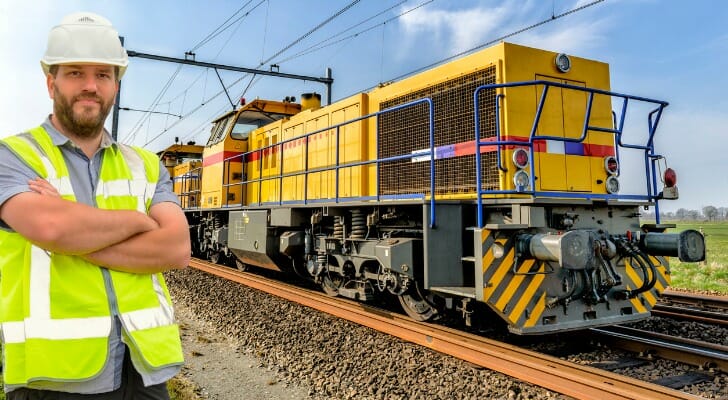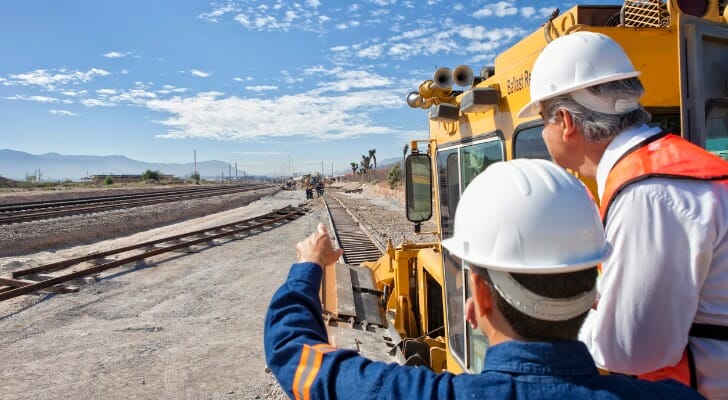The Railroad Retirement Program is a federal program that extends retirement benefits to railroad employees. The program was established in the 1930s and in addition to retirement benefits, it also pays survivor, unemployment and sickness benefits to eligible railroad workers and their families. The Railroad Retirement Board (RRB), an independent federal agency based in Chicago, is responsible for overseeing the program.
Consider working with a financial advisor as you develop a retirement plan or modify an existing one.
How the Railroad Retirement Program Works
The Railroad Retirement Program is similar to Social Security, in terms of the benefits it offers. But there are several key differences between the two.
First, railroad workers only pay money into the Railroad Retirement plan, not Social Security. The money railroad workers pay in taxes goes into funding the Railroad Retirement Program and the benefits it pays. You can’t double-dip and receive full benefits from both railroad retirement and Social Security.
The program pays benefits to workers based on the number of months of service they have as railroad employees and their earnings credits. Employees receive one month of credit for every month they work for an eligible railroad employer, regardless of how many days of the month they actually worked.
The RRB administers retirement benefit payments. These benefits can’t be paid until you end your railroad employment. You also have to reach a certain age threshold to apply for railroad retirement benefits.
When Can You Collect Railroad Retirement Benefits?
The earliest age that you can begin receiving railroad retirement benefits. is 60, if you have 30 years of qualifying railroad service. You can receive your full railroad retirement benefit at this age if you meet the 30 years of service retirement. Otherwise, you can start receiving railroad retirement benefits at age 62. But just like Social Security, your benefit amount is reduced for each year before full retirement age that you start drawing benefits.
Spouses can also receive retirement benefits once they reach a certain age. The benefit amount they’re able to draw depends on how old their spouse is, the number of years of service they have as a railroad employee and when they retire.
But generally, if you retire at age 60 with 30 years of railroad service your spouse would be able to begin receiving benefits once they turn 60 if they haven’t already. The same rules apply for reducing benefit amounts when retirement benefits are taken before your spouse reaches their full retirement age.
Railroad Retirement Program Benefits

Benefits from the Railroad Retirement Program divides benefits into two tiers. Tier I benefits are equivalent to Social Security payments and are based on the worker’s earnings and work history in both railroad and non-railroad employment. Tier II benefits are similar to a private pension and are based solely on railroad service, providing additional income beyond Tier I.
Each one got a boost in 2025 thanks to annual cost-of-living adjustments. The average regular railroad retirement employee annuity increased $69 per month to $3,538, and the average of combined benefits for an employee and spouse rose $97 a month to $5,100. For eligible widows and widowers, the average annuity increased $42 a month to $1,966.
Tier I Benefits
The first tier includes retirement, survivor and disability benefits. These benefits are available to railroad workers who have at least 10 years of service for an employer covered under the Railroad Retirement Act. The years of service requirement is shortened to five years for employees who began working for the railroad after 1995. Again, you can receive your full railroad retirement benefit starting at age 60 if you have 30 years of qualifying service. Normal full retirement age for railroad benefits between 66 and 67, depending on the year you were born.
Tier I also provides an additional but small annuity payment to eligible railroad employees who have at least 25 years of service, began working for the railroad prior to Oct. 1, 1981, and are still working for the railroad. The minimum age to receive this added benefit is 60 for workers with at least 30 years of service.
Aside from retirement benefits, Tier 1 also pays out:
- Disability benefits, similar to Social Security disability benefits
- Occupational disability benefits for people who can still perform certain types of work
- Spousal retirement benefits, including benefits for divorced spouses
- Children’s survivor benefits if a railroad employee parent is deceased
- Survivor benefits
The amount paid out for these benefits is tied to the railroad employee’s years of service and their age can also come into play for spousal benefits.
Tier II Benefits
Tier II benefits are like a private pension and are based on the employee’s average income from their five highest-earning years. The length of service an employee has also influences the minimum pension payment they’ll receive through the Tier II benefits. Current spouses and surviving widows can also receive this benefit.
While you could technically still work and receive railroad retirement benefits the way you could with Social Security, there is one catch. You can’t be employed by any organization covered under the Railroad Retirement Act. In other words, if you want to receive railroad retirement benefits and still work you’d have to choose something outside the railroad industry.
Earnings Limits for Railroad Retirement Benefits
Another change for 2025 is an increase to the amount beneficiaries can earn outside of their railroad work and not have those earnings reduce their retirement benefits.
The exempt earnings amount for those under full retirement age throughout 2025 rises to $23,400 from $22,320 in 2024. For railroad workers who reach full retirement age in 2025, the exempt earnings amount, for the months before the month they reach full retirement, increases to $62,160 in 2025 from $59,520 in 2024, according to the RRB.
People who have not reached full retirement age in 2025 are subject to an earnings deduction of $1 for every $2 of earnings over the exempt amount. For people who have reached full retirement age in 2025, the deduction is $1 for every $3 of earnings over the exempt amount in the months before the month they reach full retirement age.
When applicable, these earnings deductions are assessed on the Tier I portion of railroad retirement employee and spouse annuities, and the Tier I and Tier II portions of survivor benefits.
The RRB does not consider interest, dividends certain rental income and income from securities as earnings for this purpose. However, earnings from services rendered, plus earnings from self-employment are considered earnings when calculating a person’s earnings limits.
How to Apply for Railroad Retirement Benefits
Railroad retirement benefits don’t start automatically; you have to apply for them just like Social Security. You can do that by contacting your closest RRB office.
From there, you’ll have to complete the application for benefits. You can do so up to three months before your actual retirement date. You can submit your application over the phone, by mail or in person.
When applying for railroad retirement benefits you’ll have to provide:
- Proof of your age
- Documentation of any Social Security benefits you’re receiving
- Proof of any military service, if claimed
- Direct deposit information for your bank
Remember, you have to sever your employment with the railroad before you can apply for benefits. If your application is in order, it can take 30 to 60 days to start receiving benefits.
Bottom Line

The Railroad Retirement Program can offer generous financial benefits to railroad workers and their families. Specifically, it pays survivor, unemployment and sickness benefits to eligible railroad workers and members of their families. If you work for the railroad, it’s important to consider how these retirement benefits can help with shaping your long-term financial plan. While similar to Social Security, it is important to understand how Railroad Retirement Program benefits differ from those of Social Security.
Retirement Tips
- Consider talking to a financial advisor about when to take railroad retirement benefits and how to manage those benefits if you work for the railroad. Finding a financial advisor doesn’t have to be hard. SmartAsset’s free tool matches you with vetted financial advisors who serve your area, and you can have a free introductory call with your advisor matches to decide which one you feel is right for you. If you’re ready to find an advisor who can help you achieve your financial goals, get started now.
- Aside from employer-sponsored retirement plans, consider other ways to save and invest for the future. A traditional or Roth individual retirement account is one option that can offer tax advantages. With a traditional IRA, your contributions may be tax-deductible while a Roth IRA could offer tax-free withdrawals in retirement. Taxable brokerage accounts can also be useful in rounding out your investment strategy.
Photo credit: ©iStock.com/MiguelMalo, ©iStock.com/teppakorn tongboonto, ©iStock.com/Sjo
